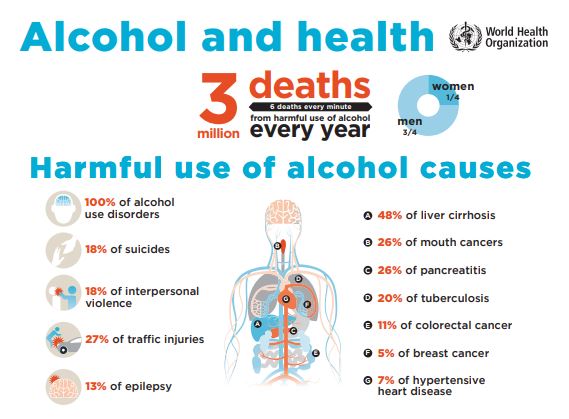
Physical Effects of Alcohol – Bone Density, Muscles, Eyes, Heart, Skin, Kidneys, Liver & Mouth
Alcohol and Bone Density
Bone is a living tissue that continues to undergo change and replacement (i.e., remodeling) even after a person has attained full stature. Long-term alcohol consumption and alcoholism can interfere with bone growth and the replacement of bone tissue, resulting in decreased bone density and increased risk of fracture. These physical effects of alcohol may be exerted directly or indirectly through the many cell types, hormones, and growth factors that regulate bone metabolism [1].
Alcohol consumption during adolescence reduces peak bone mass and can result in relatively weak adult bones that are more susceptible to fracture. In adults, alcohol consumption can disrupt the ongoing balance between the erosion and the remodeling of bone tissue, contributing to alcoholic bone disease. This imbalance results in part from alcohol-induced inhibition of osteoblasts, specialized cells that deposit new bone. Some evidence suggests that moderate drinking may decrease the risk of fracture in postmenopausal women.

Physical Effects of Alcohol on Hormones that Regulate Bone
In addition to providing structural support, bone is a major storage depot for calcium and other minerals. The small intestine absorbs calcium from ingested food, and the kidneys excrete excess calcium. An adequate concentration of calcium in the bloodstream is required for the proper functioning of nerves and muscles. The body monitors calcium concentration and responds through the action of hormones, vitamins, and local growth factors to regulate the distribution of calcium between blood and bone. Alcohol may disrupt this balance by affecting the hormones that regulate calcium metabolism as well as the hormones that influence calcium metabolism indirectly (e.g., steroid reproductive hormones and growth hormones)
Effects of Moderate Alcohol Consumption
Studies show a relationship between the consumption of large quantities of alcohol and bone loss. However, a few studies indicate that moderate alcohol consumption may help reduce osteoporosis and decrease fracture risk in postmenopausal women. For example, in a study of more than 14,000 subjects, reported that women age 65 and older who consume alcohol on more than 5 days per week had a reduced risk of vertebral deformity compared with those who consumed alcohol less than once per week.
Two recent studies investigated the influence of moderate alcohol consumption on rats following surgical removal of their ovaries to mimic menopause. In one study, rats were administered doses of alcohol equivalent to 18 percent of their total dietary caloric intake for 3 weeks. In these studies, the rats exhibited decreased bone density and bone volume compared with other rats. However, these changes were not significantly affected by alcohol administration. Although the research found fewer osteoclasts in ovariectomized alcohol-fed animals, this finding was not reflected in decreased bone volume. Therefore, neither study identified a beneficial effect of moderate alcohol consumption on bone quality.
Alcohol and Muscles
Muscle weakness from long-term alcoholism may stem from an inability of mitochondria, the powerhouses of cells, to self-repair, according to the National Institue on Alcohol Abuse and Alcoholism (NIAAA) [2] In research conducted with rats, scientists found evidence that chronic heavy alcohol use affects a gene involved in mitochondrial repair and muscle regeneration. The finding gives insight into why chronic heavy drinking often saps muscle strength and it could also lead to new targets for medication development.
Mitochondria are cellular structures that generate most of the energy needed by cells. For example, skeletal muscle constantly relies on mitochondria for power. When mitochondria become damaged, they can repair themselves through a process called mitochondrial fusion — joining with other mitochondria and exchanging material such as DNA.

Alcohol Use Contributes to Muscle Cramps
The main job of your liver is to get rid of harmful substances in your body. Your liver considers alcohol to be a harmful substance and will, therefore, make it a priority to get rid of the alcohol in your bloodstream. This fact means that other substances that the liver tries to get rid of may have to wait longer to leave your body than if you had not been drinking.
When you exercise, your body produces a chemical called lactic acid which can cause cramps. Usually, your liver tries to get rid of the lactic acid. However, when you have been drinking, the lactic acid may take longer to leave your body because your liver is trying to get rid of the alcohol instead. The lactic acid can then linger longer than usual and cause extra muscle pain and cramps.
Alcohol Makes it Harder to Build Muscle
Human growth hormone is needed to help build and maintain both muscle and collagen. The latter is a connective tissue found in tendons and ligaments. As alcohol can disrupt the function of human growth hormone levels, this may affect the ability to build muscle. In addition, human growth hormone is produced whilst we sleep and, as alcohol usually disrupts sleep patterns, the amount being produced may fall. Alcohol can also increase levels of the stress hormone cortisol, which reduces human growth hormone levels.
Alcohol Effect on Eyes
Alcohol consumption affects every function in the body, including vision. The lasting physical effects of alcohol on optical nerves, blood vessels, and brain-to-eye messaging can be referred to as “alcoholic eyes.” And conditions caused by alcoholic eyes can be short or long-lasting.
Alcohol and eyesight are connected, and even light alcohol consumption can impair the eyes and affect vision. Alcohol is a diuretic, which means it removes water from the body by making you urinate frequently. This can have a dehydrating effect in the short term, leaving the eyes dry and irritated. Dry eyes are a common complaint among drinkers, and chronic alcohol abuse can lead to the development of dry eye syndrome [3]
In addition, the relaxing physical effects of alcohol on the body can cause the blood vessels in the eyes to swell, creating bloodshot eyes or red eyes after drinking. However, alcohol, dry eyes, and bloodshot eyes from drinking are not the only temporary conditions that alcohol has on the eyes. Other short-term physical effects of alcoholic eyes include:
Involuntary Eye Movement
- When people ingest too much alcohol, messages between the brain and the eyes may not be sent or received correctly. This compromised function can cause involuntary eye movement or a jerking motion by the eyes.
Blurred or Double Vision
- Blurred vision is another side effect of drinking too much alcohol. This is another effect of diminished muscle coordination while under the influence of alcohol.
Decreased Sensitivity to Contrasting Colors
- Determining light versus dark shades becomes more difficult when under the influence of alcohol. This could make nighttime driving especially difficult.
Slower Pupil Dilation
- Pupils, when drunk, do not function well as drinking alcohol slows the response of pupil dilation. This delayed pupil reaction can cause tunnel vision and an inability to adjust to changes in light (such as oncoming headlights).
Effects of Alcohol on the Heart
The problem with most alcohol-related research is that it consists almost entirely of observational studies that only show a connection. However, the strongest evidence with heart health has shown that alcohol can increase levels of high-density lipoprotein (HDL), also known as good cholesterol. High-density lipoprotein works to keep low-density lipoprotein (LDL) or the bad cholesterol from clogging your arteries by moving it to the liver, where it’s broken down and removed from the body [4].
Many studies have found that the combination of high HDL and low LDL levels protects against heart attacks and stroke. However, this is not the most important factor in preventing heart disease, and there are other ways to increase HDL than drinking alcohol, such as regular exercise.
While moderate amounts of alcohol can offer some heart benefits, too much can have damaging effects. For instance, the more alcohol you drink at one time, the higher your heart rate gets. A sudden spike in heart rate is potentially dangerous to people with heart conditions, as it could trigger arrhythmias (irregular heartbeats).

Alcoholic Skin
Alcohol is one of the worst, most aggressive compounds to destroy your skin. It causes dehydration, inflammation, depletion of antioxidants, weakened immune system, and blood vessel ruptures. There are over hundreds of health issues connected to alcohol abuse critically affecting the body’s major systems.
Excessive consumption of alcohol causes skin damage, reduces the size of the brain, and exterminates critical brain cells, which cause cerebral disorders and compromise physical functioning. It makes the heart more susceptible to disease and strokes, while liver damage and cirrhosis can lead to the need for a liver transplant.
With the skin being the body’s largest organ and its first line of defense against outer vulnerabilities, tolerance for alcohol and skin damage is of great concern. Some of the functions of this organ include governing overall temperature and housing pain receptors. Building a tolerance to alcohol includes an increased amount and rate of consumption which speeds up the skin damage process that drinking causes. Exorbitant, long-term drinking can produce irreversible deterioration to this important body system. Essentially it’s the ultimate form of alcohol poisoning.
Alcohol and Kidneys
One of the toxins that kidneys filter from the blood is alcohol. While a drink or two now and then is probably safe for most people, heavy drinking, binge drinking, and chronic drinking is bound to damage the kidneys. Alcohol counteracts the kidneys’ toxin-filtering capacity, therefore setting the stage for further harm and increased risk of medical complications.
Besides the kidneys’ filtering of toxins function, they also help maintain the right amount of water in the body. Alcohol has a dehydrating effect, which can seriously impair the kidneys’ ability to keep bodily fluids in balance. Dehydration from alcohol affects not only the kidneys but hampers the functioning of other organs and cells.
Another adverse effect of alcohol consumption on the kidneys is what it does to blood pressure. Drinking alcohol to excess can lead to an increase in blood pressure. Alcoholics and heavy drinkers are more likely to have high blood pressure than moderate drinkers or those who abstain from drinking alcohol. Over time, this can lead to chronic high blood pressure. One of the common causes of kidney disease is high blood pressure.
There’s also the risk of liver disease from chronic drinking. To filter blood appropriately, the kidneys need blood flow to them maintained at a certain level. Among alcoholics and others with liver disease, the fine balance of blood flow and blood filtering by the kidneys is thrown out of balance.
Liver and Alcohol
A large proportion of heavy drinkers develop serious alcohol liver damage. Susceptibility to alcoholic hepatitis and cirrhosis symptoms appears to be influenced by heredity, gender, diet, and co-occurring liver illness. Most alcoholic liver disease is attributed to alcohol metabolism. Liver injury may be caused by direct toxicity of metabolic by-products of alcohol as well as by inflammation induced by these byproducts. Exposure of liver cells to bacterial toxins may contribute to liver disease. Escalating liver injury can lead to fibrosis and, ultimately, to cirrhosis. Increased understanding of the mechanisms of liver injury has led to awareness and to promote treatments for alcoholic liver disease.
Long-term heavy alcohol use is the most prevalent single cause of illness and death from liver disease in the United States. The liver is particularly susceptible to alcohol-related injury because it is the primary site of alcohol metabolism.
As alcohol is broken down in the liver, a number of potentially dangerous by-products are generated, such as acetaldehyde and highly reactive molecules called free radicals. Perhaps more so than alcohol itself, these products contribute to alcohol-induced liver damage.
Consequently, symptoms of liver damage may not appear until damage to the organ is quite extensive. Alcohol-related liver damage can be divided into three categories.
Fatty liver
- Some degree of fat deposition in the liver occurs in almost all heavy drinkers. It also may occur transiently in nonalcoholics after a single drinking session. Fatty liver is reversible and is not believed to lead to more serious damage.
Alcoholic hepatitis
- This disorder is characterized by widespread inflammation and destruction (i.e., necrosis) of liver tissue. Scar tissue may begin to replace healthy liver tissue, a process called fibrosis. Symptoms of alcoholic hepatitis may include fever, jaundice, and abdominal pain.
- The condition can be fatal but may be reversible with abstinence. Alcoholic hepatitis occurs in up to 50 percent of heavy drinkers.
Alcoholic cirrhosis
- This most advanced form of liver disease is diagnosed in 15 to 30 percent of heavy drinkers. Between 40 and 90 percent of the 26,000 annual deaths from cirrhosis are alcohol-related. A cirrhotic liver is characterized by extensive fibrosis that stiffens blood vessels and distorts the internal structure of the liver.
- Although alcoholic cirrhosis is usually fatal because of complications (e.g., kidney failure and hypertension in the vein carrying blood to the liver [i.e., the portal vein]), it can stabilize with abstinence.
Alcohol Dry Mouth
Dry mouth, after drinking a significant amount of alcohol, is a result of the redistribution of fluids in the body. It is a sign that the person is dehydrated and signals the person to drink water or other fluids that will replenish the body.
Alcohol works as a diuretic. Its chemical makeup signals to our kidneys not to reabsorb water inside the body like they normally do. This water then travels to the bladder, where it is flushed out in the urine. This abnormal loss of fluid is the cause of dehydration.
Dry mouth can be one of the symptoms of more concerning liver disease. The liver processes liquids and food, removing toxins that could harm the body. Continued alcohol use can take a toll on the liver, eventually making it unable to function properly. When the liver can’t do its job, alcohol can dehydrate the body even more than it usually does.
Continuously experiencing dry mouth can be a symptom of alcohol withdrawal. Alcohol withdrawal happens after periods of heavy alcohol use when one tries quitting alcohol or goes a long enough time without it. This is because the body adapts to having alcohol in its system. When alcohol is not present, the body shows concerning physical symptoms in its absence. Along with dry mouth, these symptoms might include shaking hands, cravings, headaches, nausea, anxiety, insomnia, and sweating.
Have You Been Struggling with Alcohol Addiction?
If you have a family member or friend who is struggling with alcohol addiction, you may want to know how you can help. Finding a treatment program and the different ways you can offer support during their recovery journey.
When a person is struggling with alcohol addiction, they may hide how much they drink, lie to themselves or others about their consumption, or deny they have a problem. This can make it difficult for them to get alcohol addiction help or for loved ones to talk with them about seeking treatment.
Treatment may involve medications to ease withdrawal symptoms, therapy through a rehabilitation program to understand the addiction and change behaviors, and long-term aftercare programming such as peer support groups to help maintain sobriety and avoid relapse. It should also be noted that no single treatment is appropriate for everyone, and plans must be reviewed and modified according to a patient’s changing needs.
Effective treatment will also focus on more than just a person’s alcohol abuse and the physical effects of alcohol. Effective treatment will seek to address other possible mental disorders. We understand how scary and overwhelming the process can be to get your loved one alcohol abuse help, but We Level Up NJ is here for you. Reach out today to speak with an admissions operator about treatment options for your loved one in order to help with their drinking problem. There’s no obligation to make any decisions right away, and all calls are 100% confidential.

Sources:
[1] NIAAA – https://pubs.niaaa.nih.gov/publications/arh22-3/190.pdf
[2] NIAAA – https://www.niaaa.nih.gov/news-events/news-releases/muscle-weakness-seen-alcoholism-linked-mitochondrial-repair-issues
[3] NIAAA – https://www.niaaa.nih.gov/alcohols-effects-health/alcohols-effects-body
[4] NCBI – https://pubmed.ncbi.nlm.nih.gov/11805530/
[5] NIAAA – https://pubs.niaaa.nih.gov/publications/arh21-1/05.pdf

